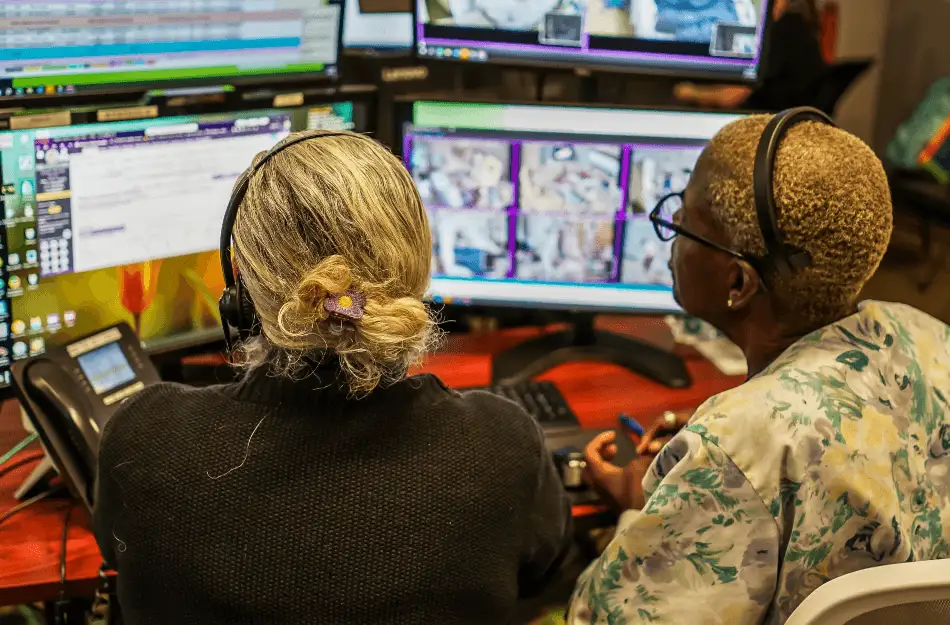It is no secret that the cost of 1:1 in person observation or “sitters” has become a major budgetary stressor in health care facilities across the country with organizations both large and small often spending upwards of a million dollars a year.
One hospital system began to tackle this issue before the days of the pandemic, when many telesitting programs were born out of necessity. This large organization supports nearly 800 adult inpatient beds, 250 child/adolescent beds, 4 emergency departments and a 4-unit inpatient psychiatric facility.
The Problem:
The cost to employee in-person siter teams was on the rise, mostly due to hiring, managing, and attrition challenges. Additionally, patient fall rates were increasing despite the in-person sitter solution and clinical staff were being removed from their roles to fill gaps when there were not enough sitters available. This caused significant dissatisfaction amongst clinical staff and the hourly rate of the 1:1 to further increase.
So, in 2017 the organization decided to combat the issues with a virtual solution. At the time, “telesitting” was a relatively foreign concept and would be met with great apprehension – change management and adoption became their next great challenge.
“In September of 2017 we would embark on journey that would become the first of its kind by replacing the 1:1 in-person observation with a remote observer monitoring and interacting with multiple patients at once in a building completely removed from the clinical space. It goes without saying, a significant amount of trust among nursing teams would have to be built and clear-cut results delivered to encourage support and adoption”. – Telehealth IT Manager
The Proposal:
A pilot fleet of 10 VirtuAlly two-way audio-visual mobile carts would be deployed to 3 inpatient units with historically high volumes of 1:1 sitter hours and high fall rates amongst its patients, while one in-patient psychiatric unit would receive fixed cameras in each and every room. Unique escalation pathways would be designed to support each deployment model. The VirtuAlly observation team would observe multiple patients that would have traditionally received 1:1 observation, with a goal to reduce the large staff of in-person sitters.
Outstanding Results:
VirtuAlly did not disappoint this hospital system. Within six months, the pilot units saw a minimum of a 50% fall reduction and a noticeable decrease in serious safety events on the psychiatric inpatient unit. This organization quickly made plans to expand VirtuAlly’s footprint. VirtuAlly would work in collaboration with the nursing teams to grow and strategize their utilization from just falls and Suicidal Ideation to a long list of use cases that would continue to cut into costly sitter hours and ultimately improve patient outcomes.
Current State:
Today, VirtuAlly’s observation team and equipment support nearly 100 endpoints on their main campus alone. The fleet now consists of 50 mobile carts and dozens of fixed cameras across all adult and children’s inpatient units as well as all emergency departments and multiple psychiatric units. One psychiatric unit saved nearly $180,000.00 in direct staffing cost alone during the first year of operation, while boosting staff retention by nearly 15%. The sitter team has since gone from a staff of nearly 50 to a staff of just five.
Recipe for Success:
The benefits of investing in a telesitting solution are impactful for any size organization. VirtuAlly’s full turnkey solution comes highly recommended: providing the equipment, the observation staff, and ongoing consultative support.
“We find that our clients who opt to utilize our full turnkey solution see a larger ROI at a much faster pace. When facilities are no longer burdened with the endless challenge of staffing and managing a team of observers or ensuring adequate coverage, they are able to keep their equipment deployed to patients around the clock and achieve cost reduction goals”. – Joe Wechsler, CEO VirtuAlly.
VirtuAlly also works with systems to customize its deployment approach- one that looks beyond just fall and sitter hour metrics. Targeting units stressed with low staff retention rates or an increased volume of safety events will continue to move the needle in achieving your ROI.
Whether a facility is looking to invest in a telesitting system for the first time or improve their current system in place, VirtuAlly’s tailored solutions offer a glass slipper approach to success based on each organization’s distinct needs.
Along Came 2020:
During the height of the pandemic, they were able to repurpose a portion of the equipment to support the reduction health care worker exposure and PPE burn. A study across just five units indicated a cost savings of $134,000.00 in PPE expenses over the course of a three-month period. ICU nurses that were met with the challenge of caring for critically ill patients in traditional inpatient rooms due to overflow could now create an ICU setting with the touch of a button.
